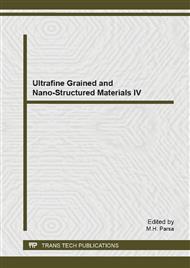p.778
p.784
p.790
p.795
p.803
p.808
p.813
p.818
p.825
Validity of Molecular Dynamics Heat Transfer by Quantum Mechanics
Abstract:
MD is commonly used in computational physics to determine the atomic response of nanostructures. MD stands for molecular dynamics. With theoretical basis in statistical mechanics, MD relates the thermal energy of the atom to its momentum by the equipartition theorem. Momenta of atoms are derived by solving Newtons equations with inter-atomic forces derived by Lennard-Jones or L-J potentials. MD implicitly assumes the atom always has heat capacity as otherwise the momenta of the atoms cannot be related to their temperature. In bulk materials, the continuum is simulated by imposing PBC on an ensemble of atoms, the atoms always having heat capacity. PBC stands for periodic boundary conditions. MD simulations of the bulk are therefore valid because atoms in the bulk do indeed have heat capacity. Nanostructures differ. Unlike the continuum, the atom confined in discrete submicron structures is precluded by QM from having the heat capacity necessary to conserve absorbed EM energy by an increase in temperature. QM stands for quantum mechanics and EM for electromagnetic. Quantum corrections of MD solutions that would show the heat capacity of nanostructures vanishes are not performed. What this means is the MD simulations of discrete nanostructures published in the literature not only have no physical meaning, but are knowingly invalid by QM. In the alternative, conservation of absorbed EM energy is proposed to proceed by the creation of QED induced non-thermal EM radiation at the TIR frequency of the nanostructure. QED stands for quantum electrodynamics and TIR for total internal reflection. QED radiation creates excitons (holon and electron pairs) that upon recombination produce EM radiation that charges the nanostructure or is lost to the surroundings a consequence only possible by QM as charge is not created in statistical mechanics. Valid and invalid MD simulations from the literature are illustrated with nanofluids and nanocars, respectively. Finally, valid and invalid MD solutions for the stiffening of NWs in tensile tests are presented to illustrate the unphysical findings if QM is ignored at the nanoscale. NW stands for nanowire.
Info:
Periodical:
Pages:
803-807
Citation:
Online since:
November 2013
Authors:
Price:
Сopyright:
© 2014 Trans Tech Publications Ltd. All Rights Reserved
Share:
Citation:


